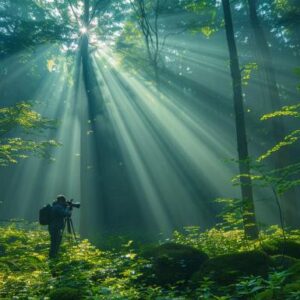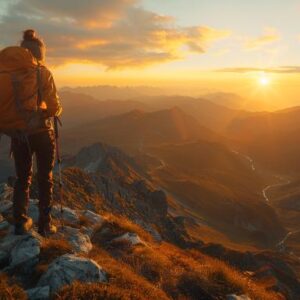You're about to set off on a memorable journey, camera in hand, destined to capture the splendor of the world — but how do you ensure your travel photos are as stunning as the experiences themselves? In “Travel Photography Tips: Capture Scenes”, we uncover the veil of secrets behind images that tell stories, that convey emotion and that perpetuate moments. Discover how to choose essential photography equipment, protect your camera from the unexpected, master the art of composition and natural light, capture human authenticity, and edit your images for lasting impact. Ready to transform your memories into works of art? Keep reading and become the traveling artist you always dreamed of being.
What are the essential equipment for travel photography?
To choose a reliable and versatile travel camera It is not done thinking only about the price. How can you ensure the camera is suitable for travel? Make sure it has a good mix of portability, durability, and image quality. Often times, a mid-level mirrorless camera or DSLR meets these requirements better than more expensive and heavier options.
How to select essential lenses for travel? Variety and versatility are keywords. Zoom lenses, like a 24-70mm or an 18-55mm, are great all-terrain. However, for landscape or architectural shots, a wide angle may be preferred, and for portraits or details, a fixed focal length lens, such as a 50mm, is ideal.
To maximize the photographic equipment safety During transit, invest in a sturdy camera bag with good padded compartments. Always lock the zipper and, if possible, choose a discreet model so as not to attract undue attention.
Let's delve deeper into the essential points:
Confidence and Versatility. Search for models with high ratings for performance in various weather conditions and ease of use.
Lens Diversity. The memory of that majestic mountain or that vibrant urban scene deserves sharpness and clarity. Quality lenses are essential.
Equipment Protection. Equipment insurance is a valuable consideration. Also purchase accessories like lens protectors and rain covers.
Assuming that travel photography aims to capture unique aspects of each destination, well-chosen equipment will be your ally in this mission to narrate evocative visuals. Not just a tool for recording, but an invitation to creativity and exploration without unnecessary overhead. And when you're armed with the right equipment, confidence follows, allowing you to fully immerse yourself in the art of capture incredible moments — always with safety in mind.
How to use composition and natural light to take stunning travel photos?
Composition techniques that can transform ordinary travel photos into extraordinary ones include using the rule of thirds, guide lines, and image depth. As for the best times to photograph landscapes while traveling, they are during golden hour – the brief period after sunrise and before sunset – as this light provides warmer, softer colors and shadows.
Let's explore this: Have you ever found yourself in front of a breathtaking scene, but the photos captured don't do justice to the beauty before your eyes? One of the keys to unlocking the potential of your photographs lies in the ability to compose the image effectively. Photography techniques for travelers They can help enhance your photographs and capture the true essence of the places you visit.
Photographic composition in tourist destinations becomes impactful when applying techniques such as rule of thirds, which involves mentally dividing the image into three horizontal and three vertical parts, positioning the most important elements at one of the intersection points or along the lines. Guide lines – whether a winding road or repeating arches – can direct the viewer's eye and create a sense of movement or depth in the photograph.
The use of natural light in travel photos is invaluable and learning to take advantage of what many call the 'golden hour' is key. During this magical period, the sunlight is soft, golden and diffuse, resulting in images full of nuances of color and shadows that intensify the atmosphere of the scene. Wait patiently for that moment, position yourself to capture the best light and see how your photos transform.
When photographing, think about how each element interacts and complements each other, creating a visual narrative even without words. Respect local culture and always ask permission when photographing people – not only is this ethical, it can also result in a more authentic and truthful portrait.
The challenge of capturing the essence of places lies in looking beyond the obvious, looking for subtle details and genuine moments that tell stories hidden in every corner. Be patient when waiting for the perfect shot, whether in the hustle and bustle of a local market or the calm of an evening on the beach.
Therefore, equip yourself with your knowledge and sensitivity, and use light and composition to your advantage to create travel photographs that not only capture, but also tell stories and excite.
How to capture authentic human portraits and moments when traveling?
When exploring foreign lands, records of local culture and customs offer a window into the hearts and minds of the communities visited. And what better way to document the essence of a place than by capturing travel portraits? However, for these portraits to be not only technically competent, but also respectful and profound, ethical and meaningful practices must be adopted.
When it comes to photographing people, What are the best practices for interacting with locals and obtaining consent before photographing them? The key is communication. Approaching respectfully and asking permission before raising your camera is essential. This not only reflects respect, but also opens doors to more authentic moments and genuine cultural exchange. A friendly smile and conversation can be the difference between a superficial portrait and a faithful representation of individuals in their natural environment.
Furthermore, How can portrait photography help tell stories of cultures and people while traveling? Through portraits, we capture something more than just faces; we capture feelings, stories and a sense of place. A good travel portrait should reveal something about the subject's personality or the culture they belong to. Whether it's the beaming smile of a child or the stormy expression of a focused craftsman, each image should allow the viewer to feel a connection to the person depicted. This is vital to telling the story of that culture or community.
When capturing travel portraits, if we strive to understand the importance of records of local culture and customs, we can produce a visual narrative rich in authenticity and empathy. It's about respecting and honoring the history and dignity of the people we are photographing, and in doing so, we ensure that the stories told through our lens are as valuable as the images we capture.
What are your editing and storage tips to ensure your travel photos make a big impact?
Have you ever returned from a trip with gigabytes of photographs awaiting review? Post-processing your images is just as vital as capturing them. Every travel photo can transform from good to exceptional with skillful edits.
How to post-process your travel photos to improve color, exposure and visual impact? Start with color correction to ensure they reflect the reality or feeling you want to convey. Adjust exposure to brighten shadowed details or highlight textures. And, like a painter at his canvas, use contrast to add depth and definition. These are basic measures to improve the look of your images and can be carried out with programs such as Lightroom or Photoshop.
Now, you might be wondering: what are the best strategies for storing and backing up your photos on the go and avoiding data loss? Consider cloud storage services, which allow you to access your photos from anywhere, and keep multiple memory cards, storing them in different locations while traveling. Also opt for reliable external hard drives as part of a 3-2-1 backup approach: three total copies of data, two of which are locally but on different media, and one offsite backup.
Travel photography seeks to capture the unique aspects of landscapes, cultures, people and experiences of each destination. Through editing, you not only preserve those memories clearly, but also enhance the visual narrative before the eyes that will encounter them. With reliable backup solutions, you ensure the perpetuity of these global snapshots, ready to inspire for generations.
On this photography journey, we explore how to equip yourself with the essentials, masterfully capture landscapes, immortalize genuine cultural expressions, and enhance your images with clever edits. Understanding the ideal camera for travel, the essential lenses and protecting your arsenal is as crucial as mastering natural light and composition techniques to capture the unforgettable. Respecting and portraying local cultures sensitively creates a travel album that tells stories. Finally, editing and secure storage are the pillars that ensure that each shot captures not just images, but eternal memories. Embark on this art, where each photo is a ticket to go back in time.
FAQ: Essential Equipment and Techniques for Travel Photography
What features should a travel camera have?
To ensure your camera is travel-friendly, it's important that it has a combination of portability, durability, and image quality. Options like mid-level mirrorless cameras or DSLRs often meet these criteria better than more expensive and heavier models.
How to choose the most appropriate lenses for traveling photography?
When selecting must-have lenses for travel, variety and versatility are key. Zoom lenses, such as the 24-70mm or 18-55mm, are versatile for different situations. For landscape or architectural photos, wide angles are recommended, while for portraits or details, fixed focal length lenses, such as the 50mm, are ideal.
What composition techniques can improve my travel photos?
Composition techniques such as the rule of thirds, guide lines and the search for image depth are essential to transform ordinary photos into extraordinary ones. Taking advantage of 'golden hour' light to capture landscapes is also crucial, as it imparts warmer, softer colors and shadows to your photos.
How can I capture authentic portraits and human moments while traveling?
To capture authentic travel portraits, approaching respectfully and asking for consent are best practices. Communication and respect cultivated with locals can lead to more genuine moments and faithful representations of people in their environments.
What are the best editing and storage practices to maintain the impact of travel photos?
In post-processing, color correction, exposure and contrast adjustment are essential initial steps to improve the visual impact of photos. For storage and backup, using cloud storage services, maintaining multiple memory cards, and using reliable external hard drives are part of the recommended strategy to ensure data security.







